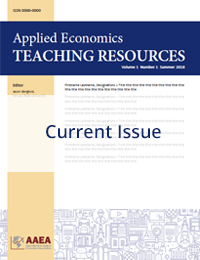Teaching Education Commentary
The Case for Transdisciplinary Data Science Education in Agricultural Economics
Jason J. Holderieath(a), Michael K. Crosby(b), Lorraine A. Jacques(c) and Pradeep Chowriapp(a)
(a)Northwest Missouri State University, (b)Louisiana Tech University, (c)University of Tampa, (d)Louisiana Tech University
JEL Codes: JEL Codes: A22, Q19, Q29, Q39
Keywords: Agricultural economics, agriculture, data science, education, transdisciplinary
First Published Online: August 13, 2025
Abstract
In agricultural fields, automation is rapidly increasing, and the needs of employers are increasingly shifting toward integrating skills in data analysis and effectively collaborating and communicating with colleagues and stakeholders. Preparation for an increasingly integrated world must challenge graduates of agricultural programs beyond their traditional silos to gain an integrated understanding of skills and techniques for the twenty-first-century workforce. Higher education is slowly shifting toward an integrative model where students gain experiences and professors facilitate their education more than talking at them for three hours per week. Here, we call for a transdisciplinary approach to education in agricultural economics where students are presented with opportunities to develop technical skills in data science and analytics and experiences to develop soft skills to ask questions and effectively communicate results. These skills will make graduates more competitive in the workforce as more data become available and more production will be needed while increasingly minimizing the ecological impact.
References
Alvargonzález, D. 2011. “Multidisciplinarity, Interdisciplinarity, Transdisciplinarity, and the Sciences.” International Studies in the Philosophy of Science 25(4):387–403.
Masad, A. [@amasad]. 2022. “[Twitter] ChatGPT Could Be a Good Debugging Companion; It Not Only Explains the Bug but Fixes It and Explain the Fix ?.” Available at:https://twitter.com/amasad/status/1598042665375105024.
Aithal, P.S., and S. Aithal. 2023. “The Changing Role of Higher Education in the Era of AI-based GPTs.” International Journal of Case Studies in Business, IT, and Education:183–197.
Chiu, T.K.F. 2024. “Future Research Recommendations for Transforming Higher Education with Generative AI.” Computers and Education: Artificial Intelligence 6:100197.
Clarke, E., and C. Ashhurst. 2018. “Transdisciplinary Theory, Practice and Education, The Art of Collaborative Research and Collective Learning.” In D. Fam, L. Neuhauser, and P. Gibbs, eds. Transdisciplinary Theory, Practice and Education: The Art of Collaborative Research and Collective Learning. New York NY: Springer International Publishing AG, pp. 151– 165.
Crawford, P., and W. Fink. 2020. “From Academia to the Workforce: Critical Growth Areas for Students Today.” APLU Series on Employability Skills in Agriculture & Natural Resources Association of Public & Land-Grant Universities. https://www.aplu.org/our-work/1-driving-equitable-student-success/preparing-students-for-the-workforce-and-post-collegiate-success/employability-skills-in-agriculture/.
Daneshpour, H., and E. Kwegyir-Afful. 2022. “Analysing Transdisciplinary Education: A Scoping Review.” Science & Education 31(4):1047–1074.
Dempere, J., K. Modugu, A. Hesham, and L.K. Ramasamy. 2023. “The Impact of ChatGPT on Higher Education.” Frontiers in Education 8:1206936.
Dyk, D. van, M. Fuentes, M.I. Jordan, M. Newton, B.K. Ray, D.T. Lang, and H. Wickham. 2015. “ASA Statement on the Role of Statistics in Data Science.” Amstat News. https://magazine.amstat.org/blog/2015/10/01/asa-statement-on-the-role-of-statistics-in-data-science/.
Fernandez, J.M., A.D. Goecker, E. Smith, E.R. Moran, and C.A. Wilson. 2020. “Employment Opportunities in for College Graduates in Food, Agriculture, Renewable Natural Resources and the Environment.” National Institute of Food and Agriculture. https://www.purdue.edu/usda/employment/report-summary/.
Flores, R.I., C.M. Soto, and C. Holliger. 2012. “Internationalization and Transdisciplinary Education in Design: Success Factors and Pitfalls.” Strategic Design Research Journal 5(2):70–74.
Gilman, D.C. 1867. “Our National Schools of Science.” The North American Review 105(217):495–520.
Gish-Lieberman, J.J., A. Tawfik, and J. Gatewood. 2021. “Micro-Credentials and Badges in Education: A Historical Overview.” TechTrends 65:5–7.
Godemann, J. 2008. “Knowledge Integration: A Key Challenge for Transdisciplinary Cooperation.” Environmental Education Research 14(6):625–641.
Guyotte, K.W., N.W. Sochacka, T.E. Costantino, J. Walther, and N.N. Kellam. 2014. “Steam as Social Practice: Cultivating Creativity in Transdisciplinary Spaces.” Art Education 67(6):12–19.
Hendrycks, D. 2023. “Natural Selection Favors AIs over Humans.” arXiv. https://doi.org/10.48550/arXiv.2303.16200.
Hern, A. 2022. “AI Bot ChatGPT Stuns Academics with Essay-Writing Skills and Usability | Technology.” The Guardian. https://www.theguardian.com/technology/2022/dec/04/ai-bot-chatgpt-stuns-academics-with-essay-writing-skills-and-usability?CMP=Share_AndroidApp_Other.
Hsiao, Y.-P., N. Klijn, and M.-S. Chiu. 2023. “Developing a Framework to Re-design Writing Assignment Assessment for the Era of Large Language Models.” Learning: Research and Practice 9(2):148–158.
Jasani, S. 2019. “Using a One Health Approach Can Foster Collaboration Through Transdisciplinary Teaching.” Medical Teacher 41(7):839–841.
Fernandez, J. [@jfernandez__]. 2022. “[Twitter] Mind-Blowing. Here Is an #RStats Shiny App I built without Writing a Single Line of Code. Just Through a Text-Based Conversation with #ChatGPT. ...and All in Under 3 Minutes.” Available at: https://twitter.com/jfernandez__/status/1599470590405976064?s=43&t=nwUJ1TZPZ-Q-3xuvNfG2ew.
Just, R.E., and G.C. Rausser. 1993. “The Governance Structure of Agricultural Science and Agricultural Economics: A Call to Arms.” American Journal of Agricultural Economics 75(Special_Issue):69–83.
Katz, D.M., M.J. Bommarito, S. Gao, and P. Arredondo. 2024. “GPT-4 Passes the Bar Exam.” Philosophical Transactions of the Royal Society A 382:20230254. https://doi.org/10.1098/rsta.2023.0254.
Larson, B.E., M.A. Sanders, and J.A. Bohler. 2021. “Aligning the Technical and Soft Skills of Management Information Systems and Business Analytics Curricula to Supplement Accounting Education.” Information Systems Education Journal:179–185.
Manyika, J., S. Lund, M. Chui, J. Bughin, J. Woetzel, P. Batra, R. Ko, and S. Sanghvi. 2017. “Jobs Lost, Jobs Gained: Workforce Transitions in a Time of Automation.” McKinsey Global Institute. https://www.mckinsey.com/~/media/mckinsey/industries/public%20and%20social%20sector/our%20insights/what%20the%20future%20of%20work%20will%20mean%20for%20jobs%20skills%20and%20wages/mgi-jobs- lost-jobs-gained-executive-summary-december-6-2017.pdf.
Martínez, E. 2024. “Re-evaluating GPT-4’s Bar Exam Performance.” Artificial Intelligence and Law:1–24. https://link.springer.com/article/10.1007/s10506-024-09396-9.
McCully, G. 2018. “Academic Disciplines: Synthesis or Demise?” New England Journal of Higher Education.
McCully, G. 1973. “Multiversity and University.” The Journal of Higher Education 44(7):514–531.
Mollman, S. 2022. “ChatGPT Gained 1 Million Users in Under a Week. Here’s Why the AI Chatbot Is Primed to Disrupt Search as We Know it.” Fortune. https://fortune.com/2022/12/09/ai-chatbot-chatgpt-could-disrupt-google-search-engines- business/?utm_source=search&utm_medium=advanced_search&utm_campaign=search_link_clicks.
National Academies of Sciences, Engineering, and Medicine. 2020. Roundtable on Data Science Postsecondary Education: A Compilation of Meeting Highlights. Washington DC: The National Academies Press. https://nap.nationalacademies.org/download/25804.
National Library of Medicine. 2022. “Data Science.” Data Glossary. https://www.nnlm.gov/guides/data-glossary/data-science.
Nicolescu, B. 2005. “Towards Transdisciplinary Education.” The Journal for Transdisciplinary Research in Southern Africa 1(1):5--15.
Pink, D.H. 2012. To Sell Is Human: The Surprising Truth About Moving Others. New York NY: Penguin Publishing Group.
Prior, J., C.M. Cusack, and A. Capon. 2018. “The Role of Pliability and Transversality Within Trans/Disciplinarity: Opening University Research and Learning to Planetary Health.” In D. Fam, L. Neuhauser, and P. Gibbs, eds. Transdisciplinary Theory, Practice and Education: The Art of Collaborative Research and Collective Learning. Cham, Switzerland: Springer, pp. 57–71.
Putra, F.W., I.B. Rangka, S. Aminah, and M.H.R. Aditama. 2023. “ChatGPT in the Higher Education Environment: Perspectives from the Theory of High Order Thinking Skills.” Journal of Public Health 45(4):e840–e841.
Rainey, C. 2023. “P(doom) is AI’s Latest Apocalypse Metric: How to Calculate Your Score.” Fast Company. https://www.fastcompany.com/90994526/pdoom-explained-how-to-calculate-your-score-on-ai-apocalypse-metric.
Rasul, T., S. Nair, D. Kalendra, M. Robin, F. de O. Santini, W.J. Ladeira, M. Sun, I. Day, R.A. Rather, and L. Heathcote. 2023. “The Role of ChatGPT in Higher Education: Benefits, Challenges, and Future Research Directions.” Journal of Applied Learning & Teaching 6(1).
Runge, C.F. 2006. “Agricultural Economics: A Brief Intellectual History.”
Sorber, N.M. 2018. Land-Grant Colleges and Popular Revolt: The Origins of the Morrill Act and the Reform of Higher Education. Ithaca NY: Cornell University Press.
Tayan, O., A. Hassan, K. Khankan, and S. Askool. 2024. “Considerations for Adapting Higher Education Technology Courses for AI Large Language Models: A Critical Review of the Impact of ChatGPT.” Machine Learning with Applications 15:100513.
Van Es, H., and J. Woodard. 2017. “Innovation in Agriculture and Food Systems in the Digital Age.” In S. Dutta, B. Lanvin, and S. Wunsch-Vincent, eds. The Global Innovation Index 2017. Geneva: World Intellectual Property Organization, pp. 97–104.
Vargas-Murillo, A.R., I.N.M. de la Asuncion Pari-Bedoya, and F.d.J. Guevara-Soto. 2023. “Challenges and Opportunities of AI-Assisted Learning: A Systematic Literature Review on the Impact of ChatGPT Usage in Higher Education.” International Journal of Learning, Teaching and Educational Research 22(7):122–135.
Warren, G.F. 1932. “The Origin and Development of Farm Economics in the United States.” American Journal of Agricultural Economics 14(1):2–9.
Weiss, D.C. 2023. “Latest Version of ChatGPT Aces Bar Exam with Score Nearing 90th Percentile.” ABAJournal. https://www.abajournal.com/web/article/latest-version-of-chatgpt-aces-the-bar-exam-with-score-in-90th-percentile.
Wickham, H., M. Çetinkaya-Rundel, and G. Grolemund. 2023. R for Data Science (2e). https://r4ds.hadley.nz/.
Woodard, J.D. 2016. “Data Science and Management for Large Scale Empirical Applications in Agricultural and Applied Economics Research.” Applied Economic Perspectives and Policy 38(3):373–388.
Worosz, M.R., B. Farrell, and C.A. Jenda. 2020. “Teaching Critical Thinking via the ‘Wicked Problem’ of Food Insecurity.” Portal: Libraries and the Academy 20(4):621–653.
Wu, S. 2024. “Artificial Intelligence-Enhanced Learning: A New Paradigm in the ‘Business Data Analysis and Application’ Course.” Journal of Contemporary Educational Research 8(2):164–175.
Yeh, R. 2016. “Convergence of Transdisciplinary Education.” Journal of Integrated Design and Process Science 19(4):3–8.
Yu, H. 2024. “The Application and Challenges of ChatGPT in Educational Transformation: New Demands for Teachers’ Roles.” Heliyon 10:e24289.
Articles in this issue
Automated Milking Systems: A Case Study of a U.S. Midwest Dairy Farm Decision-Making Process
Luis Peña-Lévano, Shaheer Burney, James Salfer, Jennifer Clark, Luis Garcia Covarrubiasa, et.al
Buyer Market Power in the U.S. Broiler Chicken Industry
Yuliya V. Bolotova
The Implementation of Non-explicit Grading
Timothy Meyer, Lia Nogueira, Fabio Mattos, Simanti Banerjee, and Kathleen Brooks
Production Economics and Efficiency: An Overview
Jean-Paul Chavas
The Case for Transdisciplinary Data Science Education in Agricultural Economics
Jason J. Holderieath, Michael K. Crosby, Lorraine A. Jacques and Pradeep Chowriapp
Exploring the Evolution of Cotton Policy: Linking Politics and Policy in Agricultural Economics Education
Julianne Treme
Commentary on Extension Programming: An Online Platform for Area-Wide Management of Western X-Disease Extension Program
Khashi Ghorbani, Shady S. Atallah and R. Karina Gallardo
Cultivating Farmers, Connections, and Careers: The Utah Urban and Small Farms Conference Experience
Katie Wagner, Kynda Curtis, Ruby Ward, Melanie Stock, and Sheriden Hansen


